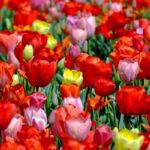Introduction - Fruits and Pollination
Pollination is a crucial factor in growing fruits. Each fruit crop, and even specific varieties within specific individual fruit crops, has distinct requirements for pollination. To keep things more simple we use only two terms on our signs, which is actually all you need to know for choosing the right varieties.
It’s also worth noting more factors that are influencing a bountiful fruit harvest.
If you want to dive deeper, find more specific terms related to fruits and pollination at the bottom.
Two terms you need to now about
1. Self-Pollinating
For fruit crops that do not need another to complete the pollination process. Most apricots, nectarines, peaches, figs and sour cherries are typical examples of self-pollinating varieties. Grapes, strawberries, blackberries, highbush blueberries, gojiberries and raspberries are typical small fruits that are self-pollinating.2. Requiring a Pollinator
For varieties that need to be pollinated by another variety. Most apples, pears, plums, sweet cherries and blueberries are typical examples of this type. It’s also good to know that, while some varieties are self-pollinating, they might have greater success when they are cross-pollinated with another. Early bloomers and late season bloomers often don’t cross pollinate because their bloom time is too far apart and the early varieties will be done blooming before the late ones start. The closer the two varieties are in bloom time, the more their bloom will overlap and the more likely you will get pollination and therefore fruit set.Some more specific pollinating information
Apples
All varieties of apple trees require some cross-pollination for a trustful fruit set. Even though some varieties are listed as self-pollinating (Cortland, Mutsu/Crispin, Spartan, Dolgo), they will set fruit more heavily and more regularly if they are cross-pollinated. Flowering crabapples have become popular pollen donors because they generally have longer bloom times than apples and are easily cared for. Dolgo is a fine example of a crabbapple that also will produce edible fruits. There are some apple varieties that cannot be used as pollinizers: Jonagold, Mutsu (aka Crispin) and some more. Although it is said that pears can pollinate apples (and not visa versa), we couldn’t find any professional sources to verify this.Pear
Pear blossoms have a short season and the small amount of nectar produced is not attractive to bees. Twice as many bees should be available to pears than for other fruits. Comice, Anjou, Bartlett are pollinating each other very well. Although Anjou, Flemish Beauty and Bartlett are partially self-fruitful, they should be cross-pollinated to produce heavy and regular crops. Bartlett, Comice and Hardy may set large crops of parthenocarpic fruit. European and Asian pears will cross-pollinate if blooming at the same time.Cherries and Plums
Sweet and sour cherries are also different species but can cross-pollinate each other, but usually cannot be pollinated by ornamental flowering cherries. Stella, Van varieties and Lapins are self-pollinating (self-fruitful). European plum varieties (Prunus domestica) can pollinate closely-related species such as damsons, mirabelles and cherry plums. European plums cannot generally cross-pollinate with Japanese plums (Prunus salicina). Many European plums are self-fertile, but most Japanese plums are not self-fertile and thus require a pollinator.Currants and Gooseberries
Currants and gooseberries are self-pollinating. Excellent fruit production can be obtained with just one plant. If currants are grown near gooseberries or jostaberries however, yields can be even better! Black currants perform better when different cultivars are grown together. Note that black currants will not cross-pollinate with red or white currants and visa versa.More pollination related terms
The following terms are often used to describe the pollination characteristics of fruit crops and other plants:
Pollination refers only to the transfer of pollen from the anthers (male structure) of one flower to the stigma (female structure) of the same or another flower. The processes of pollination and subsequent seed formation are generally necessary for fruit set and development of most fruit plants.
Self-pollination occurs when flowers are pollinated by pollen within the same horticultural variety from the same or different trees.
Cross-pollination occurs when flowers of one variety are pollinated by pollen from a second variety.
Self-fruitful implies that a single variety of a given fruit type will produce satisfactory fruit crops when grown by itself. This may occur because the variety is self-pollinating (such as peach) or because they are parthenocarpic (such as figs, and some other crops).
Cross-fruitful implies that cross-pollination is required among two or more varieties to produce satisfactory crops. Red Delicious apple varieties, for example, are cross-fruitful when cross-pollinated with varieties of Golden Delicious.
Parthenocarpic basically means fruit are produced without complete seed development, resulting in seedless fruits. Satsuma, for example, has sterile pollen, mostly nonviable ovules, and is highly parthenocarpic, which results in the production of seedless fruit.
This article goes a bit deeper for different crops.





